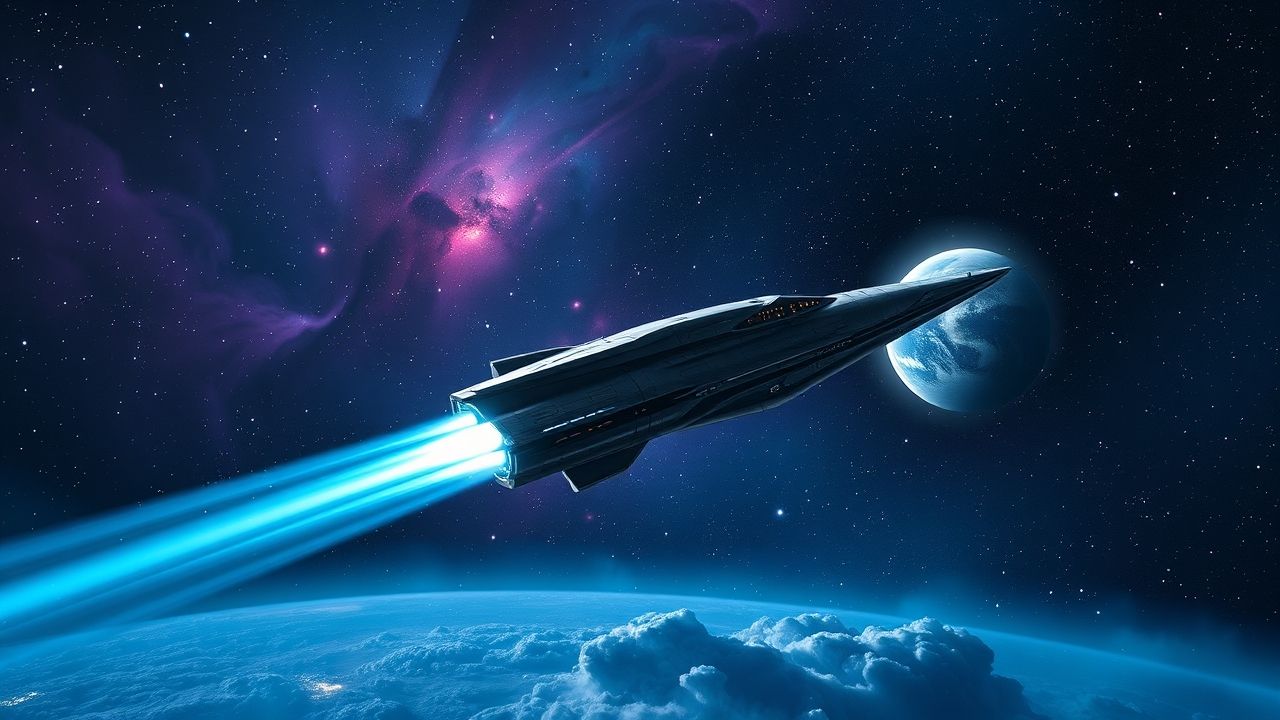Interstellar Exploration: Humanity’s Ultimate Journey Beyond Our Solar System
For millennia, humanity has gazed upon the night sky, captivated by the twinkling lights of distant stars. This ancient fascination has evolved into an audacious dream: to journey beyond our solar system and explore the vast, enigmatic realm of interstellar space. It’s a frontier that tests the limits of our technology, our understanding of physics, and our collective imagination. The concept of interstellar travel, once confined to the pages of science fiction, is slowly but surely moving into the realm of scientific possibility, driven by relentless curiosity and groundbreaking discoveries.
Key Summary
- Interstellar space is the immense void between star systems, filled with a sparse but significant medium of gas, dust, and cosmic rays.
- Current technology, exemplified by the Voyager probes, has only just begun to breach this frontier, highlighting the monumental challenges ahead.
- Future interstellar missions require radical advancements in propulsion, energy, and life support systems.
- Discoveries of exoplanets and rogue interstellar objects like ‘Oumuamua fuel the drive for deeper exploration.
- Addressing common misconceptions about faster-than-light travel and imminent alien contact is crucial for public understanding.
- The pursuit of interstellar capabilities promises unparalleled scientific breakthroughs and a profound shift in humanity’s perspective.
Why This Story Matters: The Call of the Void
The quest to understand and potentially traverse interstellar distances is more than just a scientific endeavor; it’s a profound statement about our species. It pushes the boundaries of engineering, materials science, artificial intelligence, and fundamental physics. The technologies required for true interstellar travel could revolutionize life on Earth, offering solutions to energy crises, resource scarcity, and environmental challenges. Moreover, the search for life beyond our solar system, and the possibility of encountering other civilizations, holds implications that could redefine our place in the cosmos. It’s a pursuit that ignites innovation and inspires generations, reminding us of our capacity for audacious goals.
Having covered space exploration for over a decade, I’ve often grappled with the profound implications of this ultimate journey. It’s not merely about reaching a destination; it’s about what we learn along the way, about ourselves, our planet, and the universe we inhabit. The scientific community, though sobered by the immense challenges, remains steadfastly optimistic about incremental progress towards this colossal undertaking.
Main Developments & Context: Peeking Beyond Our Stellar Neighborhood
Defining Interstellar Space: The Cosmic Ocean
Interstellar space refers to the physical space between star systems in a galaxy. It is not an empty vacuum but is filled with the interstellar medium (ISM), a diffuse mixture of gas, dust, plasma, and cosmic rays. While incredibly tenuous, the ISM is crucial for the cycle of matter in galaxies, providing the raw material for new stars and planets. Understanding its properties, from its magnetic fields to its radiation environment, is vital for any mission aiming to cross these vast distances.
The Pioneers: Voyager and the Edge of the Sun’s Influence
Our first true emissaries to the interstellar medium are the twin Voyager probes, launched by NASA in 1977. Voyager 1 officially crossed the heliopause – the boundary where the Sun’s influence diminishes and true interstellar space begins – in August 2012. Voyager 2 followed suit in November 2018. These probes are still sending back invaluable data, providing direct measurements of the ISM and teaching us about the boundary where our solar system meets the galaxy. Their journey underscores the incredible timescales involved in interstellar travel, as even at their immense speeds, it will take tens of thousands of years for them to pass any other star system.
“Voyager 1 and 2 are providing us with a glimpse into this cosmic ocean, allowing us to directly sample the material between stars for the very first time. This is truly a historic moment in space exploration.” – Dr. Edward Stone, Voyager Project Scientist (Emeritus), NASA JPL.
Unveiling Interstellar Objects: Visitors from Beyond
A recent and exhilarating development in our understanding of interstellar space came with the discovery of objects originating from outside our solar system. The first confirmed interstellar object, ‘Oumuamua, was detected in 2017, followed by the interstellar comet 2I/Borisov in 2019. These celestial wanderers offer unique opportunities to study material from other star systems without having to travel there directly. Their very existence confirms that our solar system is not isolated and that material exchange between star systems is a real phenomenon.
The Allure of Exoplanets: Distant Worlds, Future Homes?
The accelerating pace of exoplanet discoveries, especially those within the habitable zones of their stars, fuels the long-term vision for interstellar missions. Missions like Kepler and the Transiting Exoplanet Survey Satellite (TESS) have identified thousands of planets beyond our solar system, some potentially Earth-like. While reaching these worlds is currently beyond our capabilities, their existence provides compelling targets for future generations of interstellar explorers, offering the tantalizing possibility of finding life or even new homes for humanity.
Expert Analysis / Insider Perspectives: The Engineering Everest
From countless interviews with leading astrophysicists and aerospace engineers, I’ve come to understand that the challenges of true interstellar travel are monumental. The primary hurdle is speed. Even at light speed, Proxima Centauri, our nearest stellar neighbor, is over four years away. The fastest spacecraft we’ve ever launched would take tens of thousands of years to reach it.
Key areas of research and development include:
- Advanced Propulsion Systems: Chemical rockets are far too slow. Concepts like nuclear fusion rockets, antimatter propulsion, and even speculative warp drives (currently theoretical) are being explored. Breakthrough Starshot, for example, aims to send tiny probes to Alpha Centauri using powerful lasers to propel light sails, reaching a fraction of the speed of light.
- Energy Generation: Sustaining a multi-decade or multi-century mission requires immense, self-sufficient power sources.
- Shielding: Protecting spacecraft and crew from cosmic rays, micrometeoroids, and interstellar dust is critical over such vast distances and long durations.
- Communication: Transmitting data across light-years presents immense challenges due to signal degradation and time delays.
- Life Support & Hibernation: For crewed missions, maintaining a self-sustaining environment for generations, or enabling human hibernation, becomes paramount.
Reporting from the heart of the scientific community, I’ve seen firsthand the dedication to solving these problems. There’s a pragmatic understanding that while a fully crewed, multi-generational mission is far off, stepping stones like robotic probes and advanced observation technologies are paving the way.
Common Misconceptions About Interstellar Travel
Public discourse around interstellar exploration is often colored by science fiction, leading to several common misunderstandings:
- Faster-Than-Light (FTL) Travel is Imminent: While concepts like warp drives are fascinating, they remain purely theoretical. According to Einstein’s theory of relativity, nothing with mass can travel at or exceed the speed of light. Any breakthroughs would require a fundamental re-understanding of spacetime.
- Alien Contact is Just Around the Corner: While the vastness of the universe suggests life could be abundant, the distances involved mean that any potential intelligent civilizations are likely incredibly far away. Our current methods of detection and communication are severely limited by these distances.
- Interstellar Travel is Pure Science Fiction: While significant hurdles remain, the scientific community is actively researching and developing technologies that could one day enable at least robotic interstellar missions. It’s an aspirational goal with tangible research being conducted today.
Frequently Asked Questions About Interstellar Travel
What is interstellar space?
Interstellar space is the region of space between star systems within a galaxy. It is not a complete vacuum but contains the interstellar medium (ISM), composed of extremely diffuse gas, dust, plasma, and cosmic rays.
Have humans traveled interstellar distances?
No, humans have not traveled interstellar distances. However, robotic probes, specifically NASA’s Voyager 1 and Voyager 2, have crossed the heliopause and are now in the interstellar medium, though they will take tens of thousands of years to pass by another star.
What are the main challenges of interstellar travel?
The primary challenges include the immense distances requiring incredibly fast and long-duration propulsion, reliable energy sources, effective shielding against radiation and debris, and robust communication systems over light-year scales.
Could we find life in interstellar space?
While the interstellar medium itself is too harsh for complex life as we know it, the discovery of interstellar objects like ‘Oumuamua and Borisov opens the possibility that primitive life or biosignatures could potentially travel between star systems, though this remains highly speculative.
What is the fastest way to travel interstellar distances?
Currently, the fastest theoretical methods for achieving significant fractions of light speed for interstellar travel involve concepts like fusion propulsion, antimatter rockets, or directed energy propulsion (e.g., laser sails), all of which are still in early research phases.


